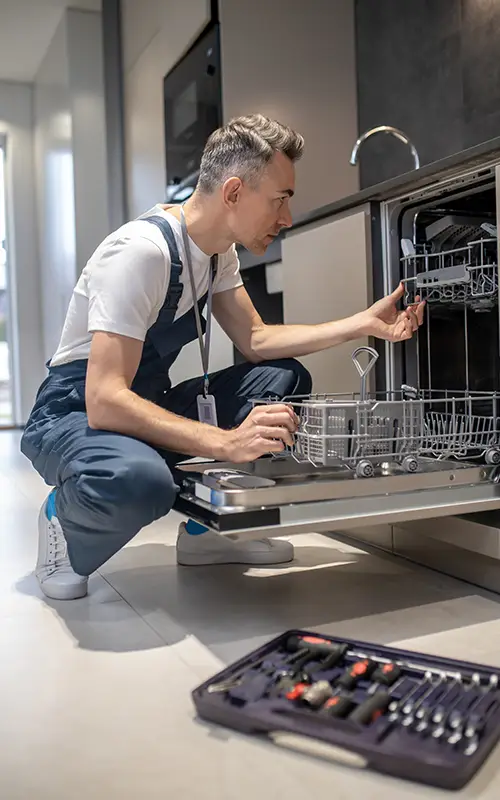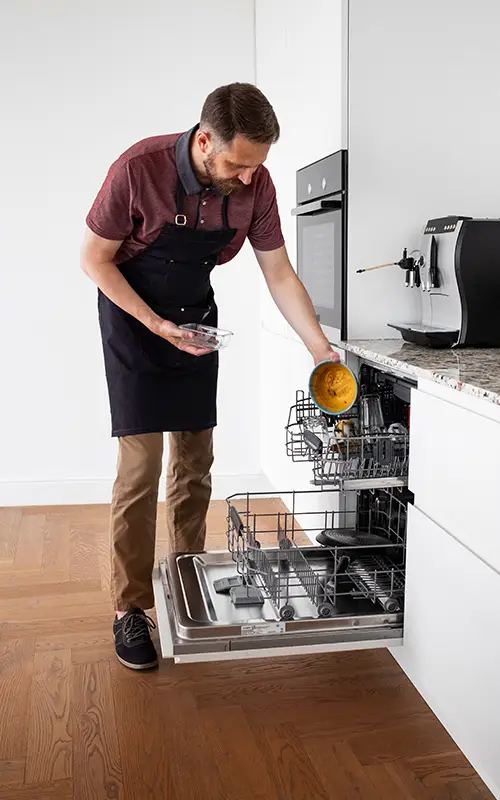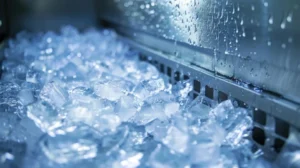The Ultimate Dishwasher Maintenance Checklist
Dishwasher Maintenance Checklist
When it comes to home appliances, the dishwasher is a true workhorse. It saves you time and effort by tackling the arduous task of washing dishes. However, like any other appliance, it requires proper care and maintenance to ensure it continues to perform at its best.
Incorporate a Dishwasher Maintenance Checklist into your routine to ensure optimal performance. Here, we will walk you through the essential steps of dishwasher maintenance. Whether you reside in Austin, TX, or anywhere else, these expert recommendations will help you keep your dishwasher running smoothly, prolonging its lifespan and saving you money in the long run.
1. Regular Cleaning
The first step in maintaining your dishwasher is regular cleaning. Over time, food particles, grease, and soap scum can accumulate inside the appliance, leading to unpleasant odors and decreased cleaning efficiency. To combat this, follow these steps:
- Remove the bottom rack and inspect the drain area for any debris or food particles. Clear any obstructions to ensure proper drainage.
- Wipe down the interior of the dishwasher, including the door and sides, with a damp cloth or sponge.
- Remove the dishwasher's filter and clean it according to the manufacturer's instructions. A clogged filter can hinder water flow and impact cleaning performance.
- Consider running a dishwasher cleaner or a mixture of vinegar and baking soda through a cycle to remove mineral deposits and eliminate odors.
2. Check for Leaks
Periodically inspect your dishwasher for leaks. Water leakage can cause significant damage to your kitchen flooring and cabinets. Here’s what you should do:
- Examine the area around the dishwasher for any signs of moisture or standing water.
- Check the water supply line and the hose connecting to the dishwasher for leaks or loose connections. Tighten any fittings as needed.
- Inspect the door seal for wear or damage. A damaged seal can allow water to escape during the wash cycle, leading to leaks. If you notice any issues, replace the door gasket.

3. Examine Door Seals
The rubber door gasket, also known as the door seal, plays a crucial role in ensuring your dishwasher remains watertight. Over time, it can wear out or become damaged, compromising the dishwasher’s efficiency. Here’s how to maintain it:
- Carefully inspect the door seal for cracks, tears, or signs of deterioration. If you notice any damage, it's essential to replace the gasket promptly to maintain a proper seal.
- Periodically clean the door seal to remove any food particles or residue that may accumulate.
4. Test Dishwasher Spray Arms
The spray arms in your dishwasher are responsible for distributing water evenly, ensuring thorough cleaning. To ensure they function correctly:
- Check that the spray arms can rotate freely. Sometimes, they can get stuck due to debris or food particles.
- Remove the spray arms and clean them thoroughly, paying special attention to the nozzles to ensure unobstructed water flow.
5. Maintain Filters
Dishwasher filters are designed to trap food particles and debris, preventing them from clogging the drain or being redeposited on your dishes. To keep them functioning optimally:
- Refer to your dishwasher's manual to locate and remove the filters.
- Clean the filters according to the manufacturer's instructions, which may include rinsing them under running water or using a soft brush to remove stubborn debris.
- Regular filter maintenance ensures that water can flow freely, improving the dishwasher's cleaning performance.

6. Use the Right Detergent
Selecting the appropriate dishwasher detergent is essential for achieving spotless dishes. Using the wrong type of detergent can lead to problems such as residue buildup and poor cleaning results. Here’s what to keep in mind:
- Choose a high-quality dishwasher detergent that matches your water hardness and dishwasher model.
- Avoid using regular dish soap, as it can create excessive suds and potentially damage your dishwasher.
7. Load Dishes Correctly
Properly loading your dishwasher is crucial for efficient cleaning and preventing damage to your dishes. Here are some tips:
- Refer to your dishwasher's user manual for guidance on loading dishes based on your specific model.
- Typically, plates should face the center, while glasses and utensils should be placed in designated racks.
- Avoid blocking the spray arms to ensure water can reach all items.
8. Run Hot Water First
Before starting a dishwasher cycle, run hot water from your kitchen tap until it becomes hot. This preheats the water entering the dishwasher, improving cleaning performance, as hot water is more effective at dissolving detergent and removing grease.
9. Inspect Spray Arms
Regularly inspect the spray arms for any clogs or obstructions that may hinder their function. If you notice any debris, remove it to ensure even water distribution during the wash cycle.
10. Avoid Overloading
Resist the temptation to overload your dishwasher, as it can lead to poor cleaning results and potential damage to the appliance. Follow the manufacturer’s guidelines for load capacity to maintain optimal performance.
11. Test for Proper Drainage
Ensure that your dishwasher drains correctly after each cycle. A clogged drain can lead to standing water inside the appliance, which can be both unsanitary and damaging. To maintain proper drainage:
- Check the dishwasher's drain area for debris or blockages. Clear any obstructions to facilitate proper water drainage.
12. Address Rust and Corrosion
Over time, the interior of your dishwasher may develop rust or corrosion, especially if it has a stainless steel interior:
- Inspect the dishwasher's interior for any signs of rust or corrosion.
- If you notice any areas with rust, address them promptly. You can use a rust-inhibiting product to prevent further deterioration.
13. Run Vinegar Rinse
Occasionally, run a vinegar rinse cycle to help remove mineral deposits and eliminate odors from your dishwasher. Simply place a cup of white vinegar on the top rack and run a hot water cycle.
14. Inspect the Power Supply
Make sure your dishwasher is properly connected to the power supply. Ensure that the power cord is securely plugged into the outlet and that there are no visible signs of damage. If your dishwasher is not functioning, check the circuit breaker to ensure it hasn’t tripped.
15. Service Your Dishwasher Annually
While regular maintenance is crucial, scheduling an annual maintenance check by a professional appliance technician can identify and address potential issues before they become major problems. Our technicians can inspect components, such as the motor, pump, and hoses, to ensure they are in good working order.
Extend the Life of Your Dishwasher and Save with Travis County Appliance Repair
Your dishwasher is a valuable appliance that simplifies your daily routine. By following these steps, you can ensure that it continues to serve you efficiently and effectively. Proper maintenance not only keeps your dishwasher in excellent condition but also extends its lifespan, saving you money on repairs and replacements in the long term. Remember, scheduling an annual professional maintenance check is a wise investment to catch any potential issues early and keep your dishwasher in top shape. Invest in the longevity of your dishwasher with Travis County Home Appliance Repair in and near Austin, TX, your trusted partner for expert appliance repair services and installation services. Ensure your appliance continues to simplify your daily routine for years to come.

Frequently Asked Question
Regular cleaning is essential to maintain your dishwasher’s efficiency. Clean the interior, filters, and spray arms monthly, and consider running a vinegar rinse every few months to remove mineral deposits and eliminate odors.
A dishwasher that’s not draining properly may have a clogged drain or a faulty pump. Check the drain area for debris and clean it as needed. If the problem persists, consult a professional technician for repairs.
No, you should never use regular dish soap in your dishwasher. Regular dish soap can create excessive suds and damage your appliance. Always use dishwasher-specific detergent to ensure proper cleaning and prevent damage.
If you notice your dishwasher is leaking, start by checking for loose or damaged connections in the water supply line and hose. Tighten any fittings as needed. If the problem persists, consult our professional technician to diagnose and address the issue.
To prevent foul odors in your dishwasher, it’s essential to maintain regular cleaning habits. Clean the interior, filters, and spray arms regularly. Additionally, running a vinegar rinse cycle every few months can help eliminate odors. Leaving the dishwasher door slightly ajar after use allows moisture to escape, reducing the chances of odors developing.
amazing things you didn't know about Appliance Repair

How to Fix a Leaky Whirlpool Ice Maker? Common Causes and Solutions
How to Fix a Leaky Whirlpool Ice Maker: 4 Common Causes and Solutions For many years, Whirlpool has been a household name in producing dependable and high-quality appliances that simplify everyday life. Among their popular

Common Reasons Your Sub-Zero Wine Cooler Not Cooling Properly
4 Common Reasons Your Sub-Zero Wine Cooler Isn’t Cooling Properly If your Sub-Zero wine cooler isn’t cooling as it should, it can be both frustrating and concerning. Maintaining the right temperature is essential for preserving

Oven Doesn’t Heat? Troubleshoot and Fix the Problem With Travis County Appliance Repair!
Oven Doesn’t Heat? Troubleshoot and Fix the Problem With Travis County Appliance Repair! An oven is the center of the kitchen, crucial for everything from quick weeknight dinners to special family feasts. It’s more than
